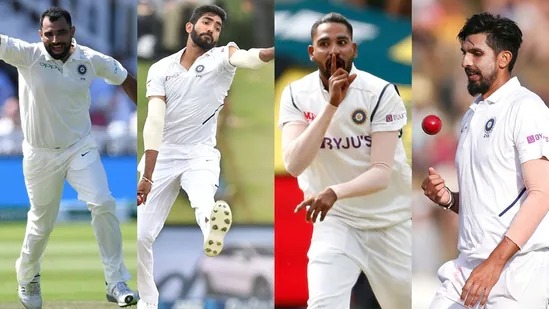Virat Kohli started nurturing a dream soon after becoming captain of the Test side. He wanted to win in places like England, Australia and South Africa. This was no daydream. Kohli had seen and understood the potential and depth of his pace attack. Different types, seasoned after a few years in international cricket, and supported by Ravi Shastri, then chief coach, and Bharat Arun, the bowling coach, this lot were raring to go.
A consistently sharper and fitter Mohammed Shami, a rejuvenated Ishant Sharma, a much-improved bowler in terms of control over skills and pace in Bhuvneshwar Kumar, a younger and hostile Umesh Yadav – this was a unit that became lethal with the addition of Jasprit Bumrah. India did not succeed the way they wanted to in England and South Africa in this period, but won Tests in most places and two landmark series in Australia. A lot of credit was reserved for the versatile pace pack. Each one of them probing all the time, it was relentless pressure on the batters. Not that they never lost the plot, but by and large, they were most effective.
Ganguly first to focus on pace
Not that Kohli was the first India captain who started laying an emphasis on pace. About a decade and a half before him, a similar thought had crossed the mind of Sourav Ganguly. He went a step further by fielding more fast bowlers in the XI at home than used to be the norm in those days. “If we want to win abroad, we need fast bowlers,” reasoned Ganguly. “And to groom fast bowlers, we have to play them at home.” Ganguly had a pool of Javagal Srinath, Zaheer Khan, Ashish Nehra and Ajit Agarkar. An upcoming Irfan Pathan joined them later.
Also Read: Can West Indies Cricket Make a Comeback?
Munaf Patel, Sreesanth, RP Singh and Pathan did well in between, not very consistently though. Then the baton passed on to the likes of Shami, Umesh and Bhuvneshwar. After Bumrah, Mohammed Siraj has been an impact bowler in the early days of his career. And that may prompt the question: ‘what next?’ It is important for the BCCI, team management and the selection committee to find an answer to this as soon as possible because this is a transition phase for the men’s senior national team, in every format. Will India be staring at a vacuum where a pool of fast bowlers used to be, or will there be a new supply chain? A home World Cup is approaching, the new World Test Championship cycle has begun, and it’s time to take decisions.
Shami and Bhuvneshwar do not have much left in the tank, Bumrah’s fitness will always remain a concern, Ishant has been discarded and Umesh may go in the same direction. Filling these voids will take a lot of doing. First choice from the second rung not long ago, Prasidh Krishna is recovering from injury. But there is a group of bowlers who are expected to get their chances in the West Indies or elsewhere in the near future. Resting Shami and dropping Umesh has opened the door for Mukesh Kumar and Navdeep Saini. Umran Malik is in the ODI mix. Shardul Thakur is there with Jaydev Unadkat. Testing himself in the Duleep Trophy is Avesh Khan, who can get in on the next tour.
Options not tested enough
On paper, this group is promising. Some of them like Shardul and Unadkat have played international cricket and that they are still around means the team finds them useful. The rest are either untested or not adequately tested. How Mukesh, Saini, Umran, Avesh or some others transform their domestic success into something substantial on the international stage has to be seen. Barring Umran, all are 25 or older. As fast bowlers, they do not have a lot of time to impress the selectors.
This is the difference between what Kohli and Ganguly had, and what Rohit Sharma has. The previous two got a set of bowlers, most of whom were finished products or did not take long to hit their straps. By the time their captains saw them, they knew how to deal with them. Kohli didn’t have to groom Shami or Ishant. This is Rohit’s disadvantage. He is still at the stage where he’s finding out what his trusted resources could be. Making things tougher is the situation – a new WTC cycle, and a World Cup looming.
But then, India’s search for the next set of fast bowlers has to begin under such circumstances. Bringing Saini back, including Mukesh in the Test squad for the first time and persisting with Umran in one-dayers are moves aimed at the future. At least a beginning has been made. How this trial-and-error process unfolds will tell us how potent India’s next-generation pace pack can be.
Also Read: Box Office Ben Stokes Lights Up the Ashes





